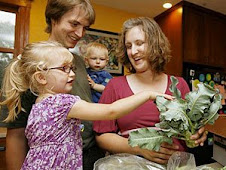We took advantage of the beautiful weather yesterday to work in the garden. Even the rain that fell for a short time was gentle and warm so we stayed out in it and we all benefited from a day under the sky.
Food-related projects included relocating the compost bin, weeding the strawberry, rhubarb, and asparagus patches, cleaning out the root cellar, collecting garlic mustard for dinner (the actual task was weeding), and checking on our cold-hardy seedlings. We also checked on our honeybees.
One hive died over winter (it's lower on the hillside so may be cooler?) but the other is still there with a population of bees. They were very active a few weeks ago but yesterday they were rather sluggish. We opened the hive to check to make sure they had enough food and we didn't even wear gloves or veils as they were very docile and didn't bother with us at all. They do have honey so we're hoping they're just resting and gearing up for the season? Hmmm. I don't know.
CompostI have to say that composting is one of my favorite pastimes. OK, OK, so it's not exactly a pastime but ever since we bought our first home 9 years ago I have thrilled at the idea of returning my food scraps and yard waste to my own yard (and thereby severely reducing my weekly output of trash). I know, it's the little things that excite me.
Anyway, for the first few months we lived in this house we had no kitchen and were in the midst of some major renovation (still are, it seems) and we didn't get around to building the compost bin of my dreams for quite some time. It absolutely pained me to throw away all the valuable food scraps during that time. So, we finally eschewed our plans to build a beautiful compost bin and just made a cylinder of hardware cloth to toss our compostable goodies into. That served us well and held what it needed to but this year we have decided to locate a sandbox for the kids where the compost bin was.
We decided to place the new bin at the end of what was our corn and brassica patch last year where it is still handy to the house (for delivering the kitchen scraps) but nicely hidden from much of the yard. The reason to hide it... we're still not building the compost bin of my dreams. Instead, we decided to be completely utilitarian and use what we had on hand to quickly get something going (it's really ugly). Kevin occasionally gets deliveries at work on wood pallets so we decided to screw three together to make a quicky bin. It took more time to haul the pallets over there then it did to screw them together! Here is it, not beautiful but functional.

As you can see, we've set the old wire cylinder next to it for yard waste. Someday, we'll build a nice set of atractive wood bins with removable front boards... someday.
The Root Cellar
I will make a full post on our root cellaring effort
s in the near future but I did spend several hours yesterday cleaning out some mice-caused mess, cleaning up from some spoiled food, and reorganizing what's left of the cellared, canned, and dehydrated foods.
"Weeding"Kevin and the kids (well, the kids played in the vicinity, anyway) spent some time weeding dandelions from the strawberry patch and turf and other non-native grasses from around the rhubarb and asparagus (which were planted in former lawn that was tilled only once prior to planting). I did a little weeding around the house of the dreaded garlic mustard which really needs to be actively controlled. The good news from that kind of project... good eats!


I know we can eat the dandelions as well (we'll be making salads all spring) but yesterday we just made use of the garlic mustard leaves. If you've never tasted garlic mustard, I recommend trying it. It has a distinct yet mild garlic flavor, coupled with the pleasant "green" flavor of most mustard greens. Now remember, we haven't had fresh greens for some time now (just frozen spinach, lambs quarters, and chard) so the prospect of fresh greens is really fantastic!
So, for an easy dinner entree after a day spent outside, I scrambled some eggs (
Angelic Organics Learning Center - Caledonia, IL) with a little butter (Madison, WI) and splash of cream skimmed from my milk share this week (
Zinniker Family Farm - Elkhorn, WI). As the eggs just started to form soft curds I added a scoop of marscapone cheese (
Crave Brothers - Waterloo, WI - cool, large-scale, sustainable farm) and the chopped garlic mustard (my yard). Yummy!

Later this week I plan to make garlic mustard pizza and garlic mustard pasta to dry or freeze for later. Although you can eat the greens all season, the tender, young leaves of the first-year rosette have the best flavor and texture.
Thing Are Growing Again
Two weekends ago, Kevin went out to prepare one of the three raised beds for planting. He pulled out the bulk of the old tomato plants, added partially decomposed leaves, and a few wheelbarrows full of dirt (this bed was not quite filled last year). He worked it all in and planted 10 kinds of frost-tolerant seeds.
He planted: Asian Early Mizuna, Green Curled Winterbor Kale, Roquette Arugula, two types of Lettuce (Green Romaine/Winter Density & Red Romaine/Rouge D'Hiver), Shunkyo Radish, Spinach, Claytonia, and two types of Corn Salad Mache (Vit & Jade). All of these plants will germinate in cool soil, thrive in cold weather, and can be harvested in baby stages in one month or less (two months to full maturity).
Here's what they look like after two weeks (and it even snowed for two days following planting!).  He's trying a bit of a controlled experiment here too. A year or so ago, my parents replaced the roof on their house, and with it, their skylights. Dad offered them to me for use as cold frame covers. We were curious how they would work so Kevin planted rows that could be half covered by these windows.The row of sticks in the middle of the bed divides the rows (there are five rows on each side of the sticks for a total of 10, one for each type of plant). The two skylights are placed at either end of the bed, covering half of each set of five rows (not all seeds have germinated).
He's trying a bit of a controlled experiment here too. A year or so ago, my parents replaced the roof on their house, and with it, their skylights. Dad offered them to me for use as cold frame covers. We were curious how they would work so Kevin planted rows that could be half covered by these windows.The row of sticks in the middle of the bed divides the rows (there are five rows on each side of the sticks for a total of 10, one for each type of plant). The two skylights are placed at either end of the bed, covering half of each set of five rows (not all seeds have germinated).
As you can see, the covered ends are growing faster than those uncovered. I assume this is to do with both the warmth (kept longer overnight) and the trapped moisture (the uncovered center soil dries out quicker). Anyway, we hope that in two more weeks we'll be able to harvest some baby greens!
Another (perhaps?) happy accident is that in the neighboring bed I see onions sprouting (I must have missed a few at harvest time) as well as lettuce (I let some go to seed last year but I didn't expect it to survive a northern Illinois winter!).  We'll see if these result in edibles as well.
We'll see if these result in edibles as well.









